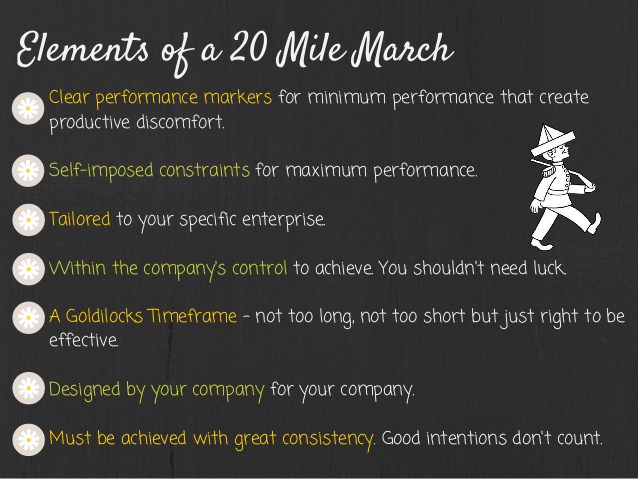Book Review: “Great by Choice”
Book: Great by Choice by Jim Collins and Morten Hansen
Reviewer: Bobby Powers
My Thoughts: 10 of 10
Jim Collins is the preeminent business mind of our generation. He brought us the business classics Built to Last and Good to Great—two works arguably referenced more than any other business books of the past two decades. His newer book Great by Choice adds to his collection of impressive work. Like his other books, Great by Choice is based on years of research into what makes companies successful. Unlike his other books, this one focuses on companies in extremely volatile industries.
Collins teams up with UC Berkeley professor Morten Hansen to explain why some companies achieve "10X" results that set them apart from their peers who experienced similar business conditions and "luck." Filled with a dozen new helpful terms to explain complex business principles (think "BHAG" and "Level 5 Leadership" from Collins' earlier works), Great by Choice is an amazing reference for both new and seasoned business readers.
Takeaways from the Book
The Research Process
- Collins and Hansen set out to answer the central question: “Why do some companies thrive in uncertainty, even chaos, and others do not?”
- “In this study, unlike any of the previous research, we selected cases not just on performance or stature but also on the extremity of the environment.”
- Collins and Hansen whittled down an initial list of 20,400 companies to 7 companies that consistently surpassed the overall market and their especially turbulent industries over a period of 15+ years.
- They compared these “10X cases” against “comparison cases” in the same industry. The 10X cases beat their industry index by at least ten times.
The 10X Cases
- Amgen (compared against Genentech)
- Biomet (compared against Kirschner)
- Intel (compared against AMD)
- Microsoft (compared against Apple)
- Sidenote: This 10X case surprised me, and I'm sure it will surprise many of you as well. Collins and Hansen look at Microsoft's performance during the Steve Jobs "wilderness years" when Apple sailed rudderless and lost sight of Jobs' and Wozniak's original vision and values. Microsoft flourished during that time.
- Progressive Insurance (compared against Safeco)
- Southwest Airlines (compared against PSA)
- Stryker (compared against USSC)
10Xers
- Norwegian explorer Roald Amundsen led the first successful expedition to the South Pole. His foresight and diligence not only led his men to success, but also to safety. During the same time as Amundsen's voyage, Captain Robert F. Scott led a separate expedition with the hope of beating Amundsen to the South Pole. Unfortunately, Scott's lack of preparation and questionable decisions resulted in his own death and the death of all his men during the expedition.* Throughout the book Great by Choice, Collins and Hansen use Amundsen as an analogy for 10X companies.
- *Note: Historians debate whether Scott truly bumbled the expedition or whether truly uncontrollable factors decided his fate. I won't opine on which story is more accurate, as I don't know. Collins and Hansen's point is that everyone is dealt windfalls of good luck and pitfalls of bad luck. Preparation can sometimes neutralize bad luck, and it's clear that Amundsen was extraordinarily prepared for his voyage.
- “[Amundsen] designed the entire journey to systematically reduce the role of big forces and chance events by vigorously embracing the possibility of those very same big forces and chance events. He presumed bad events might strike his team somewhere along the journey and he prepared for them, even developing contingency plans so that the team could go on should something unfortunate happen to him along the way.”
- “On the one hand, 10Xers understand that they face continuous uncertainty and that they cannot control, and cannot accurately predict, significant aspects of the world around them. On the other hand, 10Xers reject the idea that forces outside their control or chance events will determine their results; they accept full responsibility for their own fate.”
- 10Xers exhibit “a triad a core behaviors: fanatic discipline, empirical creativity, and productive paranoia. Animating these three core behaviors is a central motivating force, Level 5 ambition.”
- “10Xers channel their ego and intensity into something larger and more enduring than themselves. They’re ambitious, to be sure, but for a purpose beyond themselves, be it building a great company, changing the world, or achieving some great object that’s ultimately not about them.”
20 Mile March
- During Amundsen's journey, he and his men faced many days of good weather and many days of bad weather. Rather than trekking long distances in good weather and making little or no progress in bad weather, Amundsen decided to trek a reliable distance of roughly 20 miles per day. His “20 Mile March” is a perfect example of the persistence needed to achieve success in any realm, including business.
- “Throughout the journey, Amundsen adhered to a regimen of consistent progress, never going too far in good weather, careful to stay far away from the red line of exhaustion that could leave his team exposed, yet pressing ahead in nasty weather to stay on pace. Amundsen throttled back his well-tuned team to travel between 15 and 20 miles per day, in a relentless march to 90 degrees South. When a member of Amundsen’s team suggested they could go faster, up to 25 miles a day, Amundsen said no. They needed to rest and sleep so as to continually replenish their energy.”
- “Victory awaits him who has everything in order--luck people call it. Defeat is certain for him who has neglected to take the necessary precautions in time; this is called bad luck.” -Roald Amundsen
- “The 20 Mile March is more than a philosophy. It’s about having concrete, clear, intelligent, and rigorously pursued performance mechanisms that keep you on track. The 20 Mile March creates two types of self-imposed discomfort: (1) the discomfort of unwavering commitment to high performance in difficult conditions, and (2) the discomfort of holding back in good conditions.”
- “Accomplishing a 20 Mile March, consistently, in good times and bad, builds confidence. Tangible achievement in the face of adversity reinforces the 10X perspective: we are ultimately responsible for improving performance. We never blame circumstance; we never blame the environment.”
- “The 20 Mile March was a distinguishing factor, to an overwhelming degree, between the 10X companies and the comparison companies in our research.”
Fire Bullets, then Cannonballs
- “First, you fire bullets to figure out what’ll work. Then once you have empirical confidence based on the bullets, you concentrate your resources and fire a cannonball. After the cannonball hits, you keep 20 Mile Marching to make the most of your big success.”
- “Retrospective accounts tend to focus on only the big cannonballs, giving the false impression that 10X achievements come to those with the guts to go always for the big bet, the huge cannonball. But the historical research evidence presents a different story, a story of dozens of small bullets that thumped into the dirt, punctuated by a handful of cannonballs that smashed into their targets.”
- “10Xers appear to have no better ability to predict impending changes and events than the comparisons. They aren’t visionary geniuses; they’re empiricists.”
Leading Above the Death Line
- “10Xers remain productively paranoid in good times, recognizing that it’s what they do before the storm comes that matters most. Since it’s impossible to consistently predict specific disruptive events, they systematically build buffers and shock absorbers for dealing with unexpected events. They put in place their extra oxygen canisters long before they’re hit with a storm.”
- “When a calamitous event clobbers an industry or the overall economy, companies fall into one of three categories: those that pull ahead, those that fall behind, and those that die. The disruption itself does not determine your category. You do.”
- “We will all face moments when the quality of our performance matters much more than other moments, moments that we can seize or squander. 10Xers prepare for those moments, recognize those moments, grab those moments, upend their lives in those moments, and deliver their best in those moments. They respond to unequal times with unequal intensity, when it matters most.”
SMaC
- “A SMaC recipe is a set of durable operating practices that create a replicable and consistent success formula. The word ‘SMaC’ stands for Specific, Measurable, and Consistent...SMaC practices can last for decades and apply across a wide range of circumstances.”
- “When faced with declining results, 10Xers do not first assume that their principles and methods have become obsolete. Rather, they first consider whether the enterprise has perhaps strayed from its recipe, or has forgone discipline and rigor in adhering to the recipe.”
- “If you really want to become mediocre or get yourself killed in a turbulent environment, you want to be changing, morphing, leaping, and transforming yourself all the time and in reaction to everything that hits you. We’ve found in all our research studies that the signature of mediocrity is not an unwillingness to change; the signature of mediocrity is chronic inconsistency.”
- “Changes to a solid and proven SMaC recipe are like amendments to the Constitution: if you get the recipe right, based on practical insight and empirical validation, it should serve you well for a very long time; equally important, fundamental changes must be possible. Continually question and challenge your recipe, but change it rarely.”
- “Far more difficult than implementing change is figuring out what works, understanding why it works, grasping when to change, and knowing when not to.”
Return on Luck
- “The real difference between the 10X and comparison cases wasn’t luck per se but what they did with the luck they got. Adding up all the evidence, we found that the 10X cases were not generally luckier than the comparison cases. The 10X cases and the comparisons both got luck, good and bad, in comparable amounts. The evidence leads us to conclude that luck does not cause 10X success. People do. The critical question is not ‘Are you lucky?’ but ‘Do you get a high return on luck?’”
- “Getting a high return on luck requires throwing yourself at the luck event with ferocious intensity, disrupting your life, and not letting up.”
- “Goals live on the other side of obstacles and challenges. Along the way, make no excuses and place no blame.” -Ray Bourque
- “We all get bad luck. The question is how to use that bad luck to make us stronger, to turn it into ‘one of the best things that ever happened,’ to not let it become a psychological prison. And that’s precisely what 10Xers do.”
Think you’d like this book?
Other books you may enjoy:
- Antifragile by Nassim Nicholas Taleb
- Good to Great by Jim Collins
- Into Thin Air by John Krakauer
Other notable books by the authors:
- Good to Great by Jim Collins
- Built to Last by Jim Collins and Jerry Porras
- How the Mighty Fall by Jim Collins
- Great at Work by Morten Hansen
Want to become a stronger leader?
Sign up to get my exclusive
10-page guide for leaders and learners.







